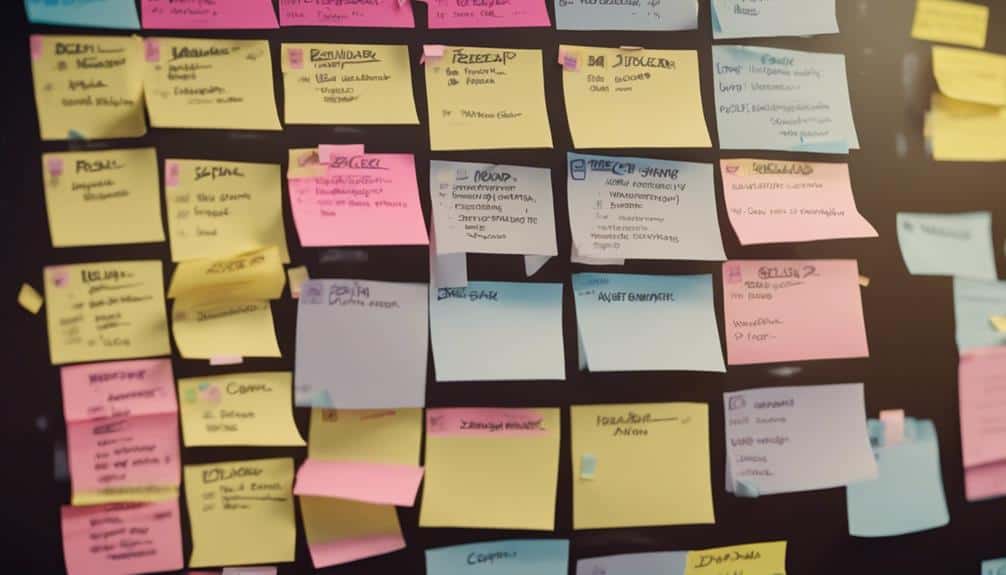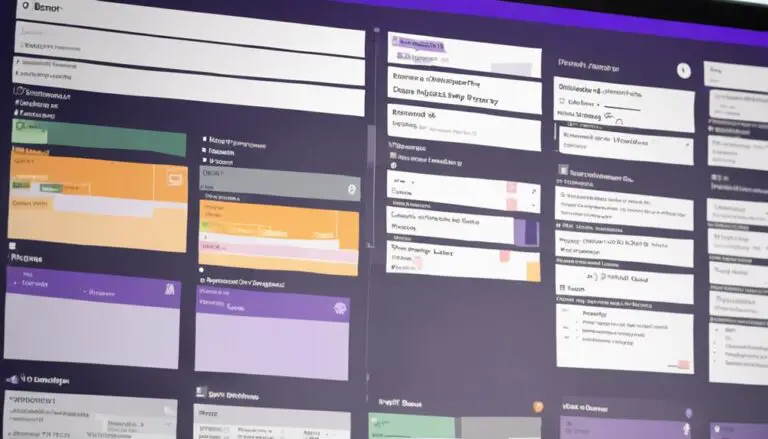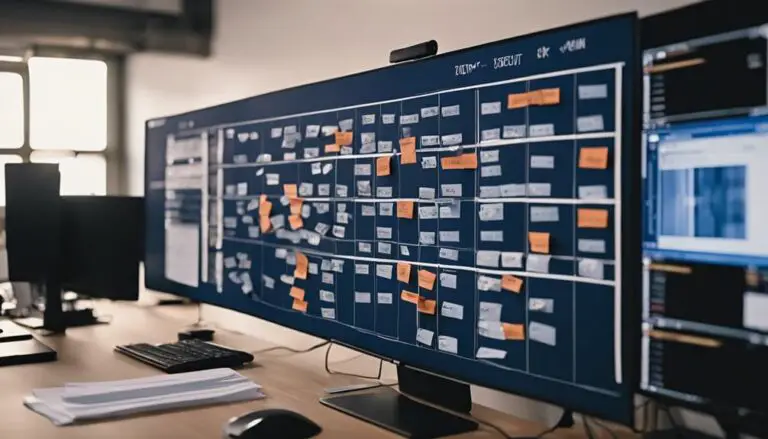You might find it intriguing that a recent study revealed that teams using Kanban within their sprints experienced a 20% increase in productivity. Wondering how exactly this method achieves such results and what strategies can be harnessed for your own projects?
The comprehensive guide on 'How Kanban Uses Sprints' offers insights into integrating Kanban practices seamlessly into the sprint framework, shedding light on key aspects like sprint planning, monitoring progress, leveraging flow metrics, and more. One of the key elements of integrating Kanban into sprints is the use of kanban board sprints, where teams visualize their workflow and limit work in progress. This allows for better visibility and understanding of the tasks at hand, and helps in identifying and addressing bottlenecks. By incorporating kanban board sprints, teams can better focus on continuous improvement and delivering value to their customers.
Key Takeaways
- Kanban integrates sprints for flexibility and efficiency
- Sprint planning in Kanban emphasizes transparency and adaptation
- Sprint duration in Kanban varies for optimal workflow
- Kanban utilizes story points and metrics for planning and improvement
Kanban and Scrum Integration
When integrating Kanban and Scrum, you can enhance flexibility in managing work items within sprints. By utilizing Kanban boards within the Scrum framework, you can visualize your sprint commitments and track the progress of work items through active stages.
This integration allows you to leverage flow metrics to measure efficiency and monitor advancements during sprints effectively. The use of story points and sprint velocity on Kanban boards further aids in maintaining Scrum practices while benefiting from the visual workflow management of Kanban.
The transparency and adaptability offered by Kanban within Scrum create a conducive environment for continuous improvement in your development processes. Embracing this integration not only streamlines your work but also provides valuable insights into your team's performance, fostering a sense of collaboration and belonging as you work towards achieving your sprint goals efficiently.
Sprint Planning in Kanban
Sprint Planning in Kanban optimizes the selection and refinement of Product Backlog items for specific timeframes, prioritizing a steady flow of work items and the delivery of high-quality increments. When engaging in Sprint Planning within the Kanban framework, consider the following:
- Utilize Kanban Board: Visualize Sprint Backlog items, tasks, and their progress on a Kanban board for enhanced transparency and collaboration.
- Focus on High-Quality Increments: Emphasize the importance of creating high-quality deliverables during each sprint to ensure continuous improvement and customer satisfaction.
- Embrace Adaptation: Kanban encourages continuous adaptation, allowing teams to adjust priorities and refine backlog items as needed for optimal results.
- Negotiate Scope and Fidelity: Use Kanban principles to facilitate negotiations regarding the scope and fidelity of backlog items, ensuring alignment with team capabilities and customer expectations.
Executing Sprints in Kanban
Let's kick off a discussion on executing sprints in Kanban by focusing on essential points such as sprint duration, task prioritization methods, and tracking progress efficiently.
Understanding the sprint duration helps in setting a clear timeframe for completing tasks, while effective task prioritization ensures that the most valuable items are addressed first.
Tracking progress efficiently enables you to stay on top of work completion and adjust priorities as needed for a successful sprint outcome.
Sprint Duration in Kanban
To effectively manage Sprint Duration in Kanban, teams focus on continuous delivery and flow rather than sticking to fixed time constraints like in Scrum. In Kanban Sprints, the time-boxed period for completion can be flexible, allowing teams to adapt to project needs and work nature.
Here are some key points to consider:
- Kanban Sprint duration varies based on team preferences and project requirements.
- Teams can choose to work on a specific goal or a set amount of work items within the Sprint period.
- The emphasis in Kanban Sprints is on completing work items rather than meeting strict time frames.
- Flexibility and adaptability are promoted in Kanban Sprints, encouraging continuous improvement and optimization of workflow.
Task Prioritization Methods
When prioritizing tasks in Kanban for executing sprints, consider utilizing classes of service to categorize and manage work items effectively. This categorization helps in determining which tasks are most critical for the Sprint backlog.
By using classes of service, Scrum teams can prioritize tasks based on urgency and importance during Sprint Planning sessions. Implementing expedite policies allows urgent tasks to be fast-tracked when necessary, ensuring that the most crucial work is addressed promptly.
Limiting work in progress (WIP) is also essential in maintaining focus and ensuring that only the most important tasks are being worked on at any given time. Visualizing work items on the Kanban board aids teams in making informed decisions regarding task prioritization, ultimately leading to more efficient Sprint execution.
Tracking Progress Efficiently
Consider incorporating Kanban's visual tracking system to monitor progress efficiently while executing sprints, ensuring alignment with sprint goals and timely completion of work items. Utilize Kanban boards for clear visualization, setting WIP limits, and managing flow.
Measure cycle time to understand how long tasks take to move from start to finish, helping identify bottlenecks. Implement flow metrics to analyze and improve process efficiency, enabling teams to deliver work items smoothly and meet sprint objectives effectively.
Monitoring Progress in Sprints
Monitor sprint progress effectively by tracking completed work items daily and visualizing tasks moving through Kanban boards. This approach allows you to stay on top of the user stories or work items planned for the sprint within the Scrum framework.
By comparing what was initially planned with the actual work completed each day, you can gauge the team's progress accurately. Utilize Cumulative Flow Diagrams to analyze work in progress and identify any bottlenecks affecting your sprint's cycle time. These visual representations help you understand how tasks are flowing through different stages, enabling you to make informed decisions to keep the sprint on track.
Additionally, conducting sprint retrospectives is vital to reflect on the progress made during the sprint and uncover areas for enhancement in the future. By actively monitoring progress in sprints, you foster transparency, collaboration, and continuous improvement within your team.
Utilizing Story Points in Kanban
Wondering how story points can enhance your Kanban process?
Story points play a crucial role in Kanban as they help teams estimate the effort required for work items and provide a common understanding of task complexity. Here are some ways story points can be utilized effectively:
- Estimating Effort: Story points serve as a valuable tool for estimating the level of effort needed for each task.
- Visualizing Complexity: By visualizing story points on Kanban cards, teams can easily see the size and effort required for different tasks.
- Using Fibonacci Sequence: The Fibonacci sequence is commonly employed in Kanban for detailed estimations, offering a structured approach to the process.
- Calculating Velocity: Tracking story points allows teams to calculate velocity, enabling them to make informed decisions during planning and improve their workflow efficiency.
Leveraging Flow Metrics in Sprints
To amplify the efficiency and effectiveness of your sprint processes, harnessing flow metrics in Kanban is essential for optimizing work item flow within your sprints. By utilizing flow metrics such as cycle time, throughput, and WIP aging, your team members can better analyze and improve process efficiency.
Cycle Time Scatterplots provide insights into task completion durations, helping you pinpoint areas for improvement. Throughput Run Charts enable you to monitor the rate of work item delivery, allowing for better predictability and planning within sprints. Additionally, WIP Aging charts assist in identifying bottlenecks and delays by tracking the age of work items in progress.
Forecasting With Kanban
Let's explore how Kanban can help you make accurate predictions by using metrics for forecasting.
By analyzing data-driven projections in Kanban, you can anticipate future deliveries and optimize team performance.
Utilize tools like Cycle Time Scatterplot and Throughput Run Chart to track progress and identify potential bottlenecks for improved forecasting capabilities.
Kanban for Predictions
When utilizing Kanban for predictions, you can rely on historical data and flow metrics to accurately forecast future deliveries. Here are some key tools and techniques in Kanban for enhancing your predictive capabilities:
- Throughput Run Charts: These charts help you track delivery rates over time, providing insights for forecasting.
- WIP Aging Charts: By monitoring aging work items, you can anticipate potential delivery delays.
- Monte Carlo Simulations: Utilizing simulations aids in predicting sprints, releases, and projects based on team capacity.
- Epics Visualization: Kanban visualizes epics on top of sprints, connecting them to larger initiatives for more accurate release forecasting.
Using Metrics for Forecasting
Enhance your forecasting capabilities in Kanban by leveraging key metrics such as:
- Monte Carlo simulations
- Cycle Time Scatterplot
- Throughput Run Chart
- WIP Aging chart
These tools help track and analyze project progress effectively. Track cycle time to understand how long it takes to complete work items, monitor delivery rate with the Throughput Run Chart to gauge completion speed, and use the WIP Aging chart to identify bottlenecks.
Data-Driven Projections in Kanban
To improve your forecasting accuracy in Kanban, utilize data-driven projections by leveraging historical cycle time data for accurate future delivery forecasts. Incorporate the following strategies to enhance your forecasting capabilities:
- Throughput run charts: Track delivery rate trends to predict future throughput accurately.
- WIP aging charts: Monitor aging work items to estimate completion times effectively.
- Monte Carlo simulations: Forecast sprints, releases, and projects based on team capacity using probabilistic modeling.
- Cycle time metrics: Analyze throughput and cycle time data to make informed projections about future work completion.
Key Insights for Kanban Sprints
For a deeper understanding of Kanban sprints, consider these key insights that illuminate the essence of this agile methodology. In Kanban, user stories play a crucial role in defining the work that needs to be done during sprints. Backlog must be continuously refined and prioritized to ensure that the team is focusing on the most valuable tasks. Combining Scrum with Kanban can enhance the effectiveness of sprints by incorporating Scrum ceremonies like sprint planning and sprint reviews into the Kanban framework.
Kanban sprints are about creating a rhythm for continuous delivery and feedback, allowing teams to concentrate on completing work and delivering value within a specific timeframe. By embracing sprints, teams can maintain a steady flow of work while having the flexibility to adapt to changing priorities. These short-term goals set during sprints help measure progress and drive continuous improvement. Collaboration, visibility, and incremental value delivery to stakeholders are at the core of Kanban sprints, emphasizing teamwork and shared goals.
Frequently Asked Questions
How Does Kanban Work With Sprints?
In Kanban, you won't find sprints like in Scrum. Instead, focus on continuous flow, visualizing work, and improving efficiency. Embrace flexible prioritization, iterative development, and continuous improvement for a smoother workflow.
How Do I Manage Sprints in Kanban Board?
You manage sprints in a Kanban board by planning sprints, collaborating with your team, and prioritizing tasks. Visualize sprint goals, use swimlanes, and track progress to control work in progress and improve continuously.
What Is the Sprint Goal in Kanban?
In Kanban, the Sprint Goal is a key focus for a short period, usually 1-4 weeks. It guides your work, aiming for specific outcomes that contribute to the overall project. Collaborate, deliver incrementally, and improve continuously.
What Are the 3 Elements of Kanban?
In Kanban, the three core elements are visualizing work, limiting WIP, and enhancing flow efficiency. These principles align with Lean methodology and Agile practices, facilitating continuous improvement and efficient workflow management. Embrace these Kanban principles for success.
Conclusion
As you wrap up your Kanban journey within the Scrum framework, remember that the key to success lies in continuous improvement and collaboration.
By combining the flexibility of Kanban with the structure of Sprints, you can achieve remarkable results and drive your team towards excellence.
Keep pushing boundaries, embracing change, and striving for transparency in your processes.
The possibilities are endless when you harness the power of Kanban within your Sprints.
Let's keep moving forward together!





